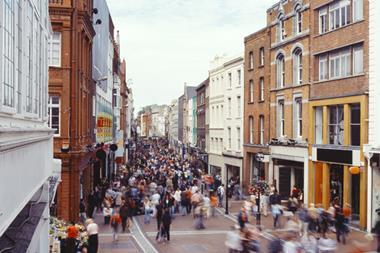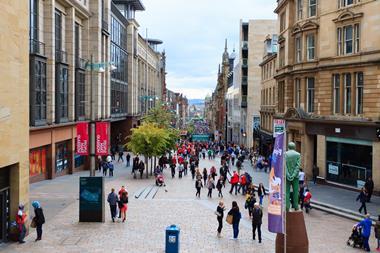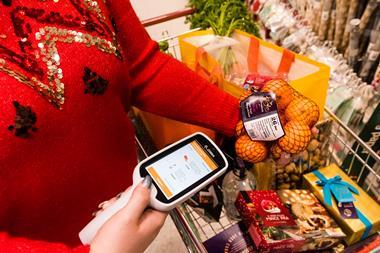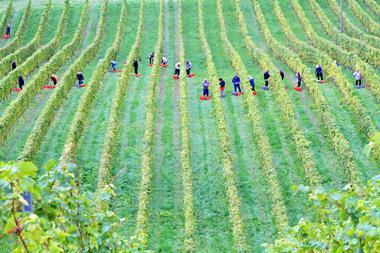
Top story
UK retail footfall over the festive period rose back to the highest levels recorded since the start of the Covid pandemic in 2020
According to data from the BRC-Sensormatic IQ Footfall Monitor for the five weeks to 31 December, total UK footfall for the period was down by 7.3% - but this represented a 6 percentage point improvement from November and was significantly better than the overall 11.8% footfall drop during the year.
The total 2022 footfall drop of 11.8% on pre-pandemic levels also represented a significant improvement on the 33.2% drop compared to pre-Covid in 2021.
During the five-week Christmas period high street footfall declined by 9.3% compared to pre-pandemic levels, 4.3 percentage points better than last month’s rate and better than the 3-month average decline of 11.0%.
Retail Parks saw footfall decrease by 5.2%, while shopping centre footfall declined by 19.9% (albeit still 3.3 percentage points better than last month’s rate).
On a year-on-year basis compared to 2021 total footfall increased by 15.1%; High Streets by 19.7% and shopping centres by 13.4%. However, retail parks were down by 1.6%.
BRC CEO Helen Dickinson commented: “Footfall reached its highest level since the start of the pandemic in December. A combination of rail disruption and the cold snap kept many shoppers from visiting town centres and high streets in the last week before Christmas. Meanwhile, the postal strikes forced others to head in for the last week to secure last minute gifts in-store.
“Historically low consumer confidence and 30-year-high inflation made for an exceptionally difficult year for consumers and retailers, with footfall down over 10% on pre-pandemic levels. Nonetheless, this was still a significant improvement on the previous two years when the pandemic kept many people at home. Although retailers’ input costs show little sign of easing in 2023, they continue to do all they can to keep prices affordable and tempt customers in.”
Andy Sumpter, Retail Consultant EMEA for Sensormatic Solutions, added: ““Physical retail rallied in December, with store performance last month posting its best footfall counts compared to pre-pandemic figures all year. Retailers rose above an onslaught of festive disruption, from snow chaos to rail and mail strikes impacting consumers’ shopping journeys both on- and off-line, disrupting pre-Christmas travel to shopping hubs and creating online delivery backlogs and delays. And, once again, it was the in-store teams that kept retailers’ doors open and able to continue to serve their customers and communities.
“Looking ahead to 2023, retailers will be hoping for more stability and support to help them chart a trading course for success in the light of continued economic headwinds, as they adapt their retail offers to the needs of the cost-of-living consumer.”
Morning update
On the markets this morning, the FTSE 100 has gained another 0.2% to reach 7,649.5pts and edge closer to post-pandemic highs.
Early risers include McBride, up 6.3% to 21.9p, Hotel Chocolat, up 4.1% to 195.7p and Science in Sport, up 3.6% to 14.5p.
Fallers so far today include THG, down 3.7% to 47.5p, Deliveroo, down 2.2% to 93.9p and Domino’s Pizza Group, down 1.8% to 299.7p.
Yesterday in the City
The FTSE posted its third successive day of post-Christmas gains yesterday, rising another 0.6% to 7,633.5pts.
B&M European Value Retail gained a modest 0.5% to 447.4p and Greggs lost 1% to 2,418p despite their upbeat trading announcements yesterday morning.
Risers included Hilton Food Group, up 5.7% to 580p, Hotel Chocolat, up 4.4% to 188p, Associated British Foods, up 4.3% to 1,744.5p, Greencore, up 4.3% to 69.1p, Marks & Spencer, up 3.4% to 136.2p and Premier Foods, up 2.6% to 112.8p.
Amongst the fallers were Wynnstay Group, down 7.5% to 545p, Fevertree, down 3.8% to 1,039p, Haleon, down 3% to 313p, Nichols, down 1.4% to 1,095p, Tate & Lyle, down 1.3% to 726.2p and Naked Wines, down 1% to 134.6p.



















No comments yet